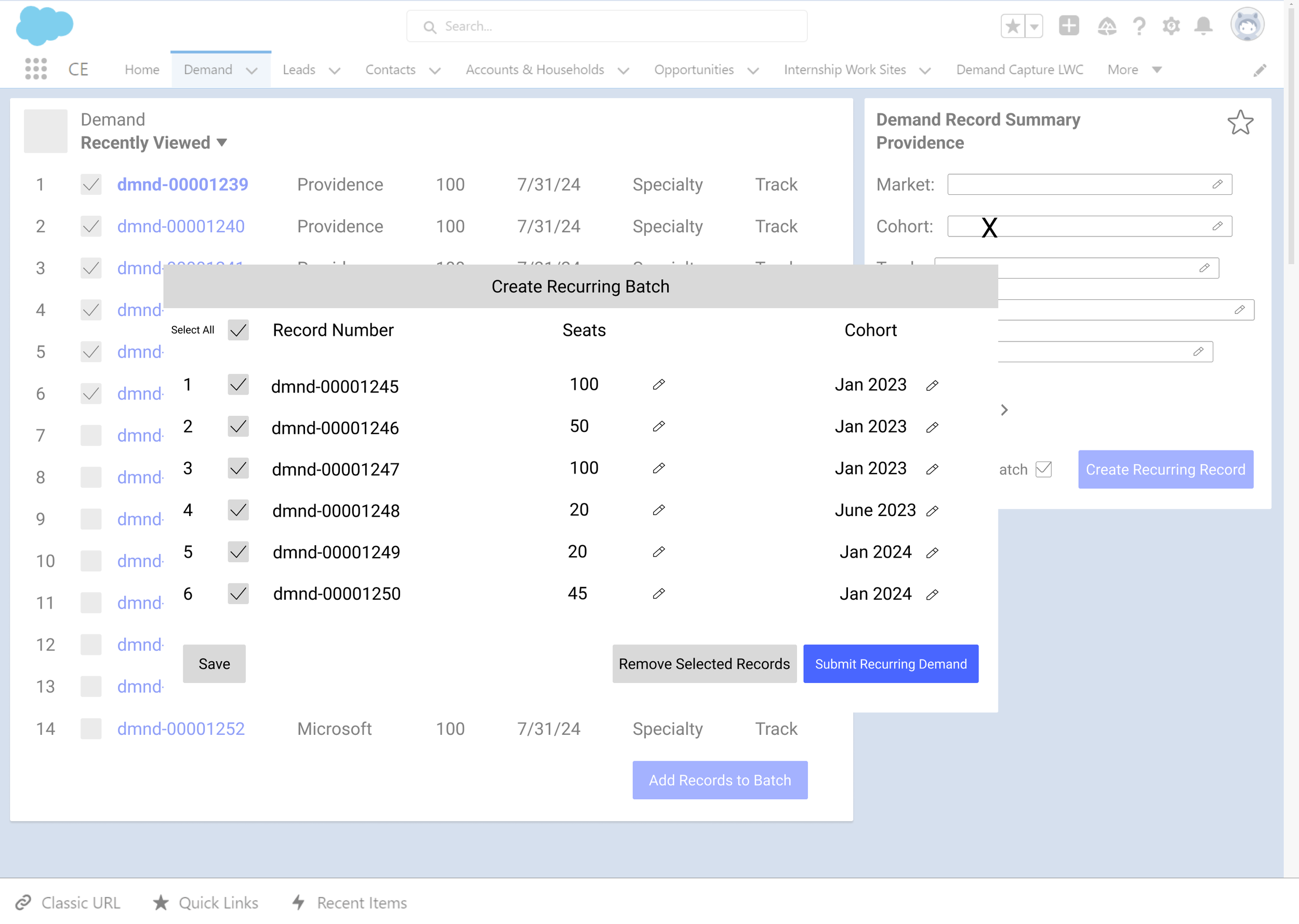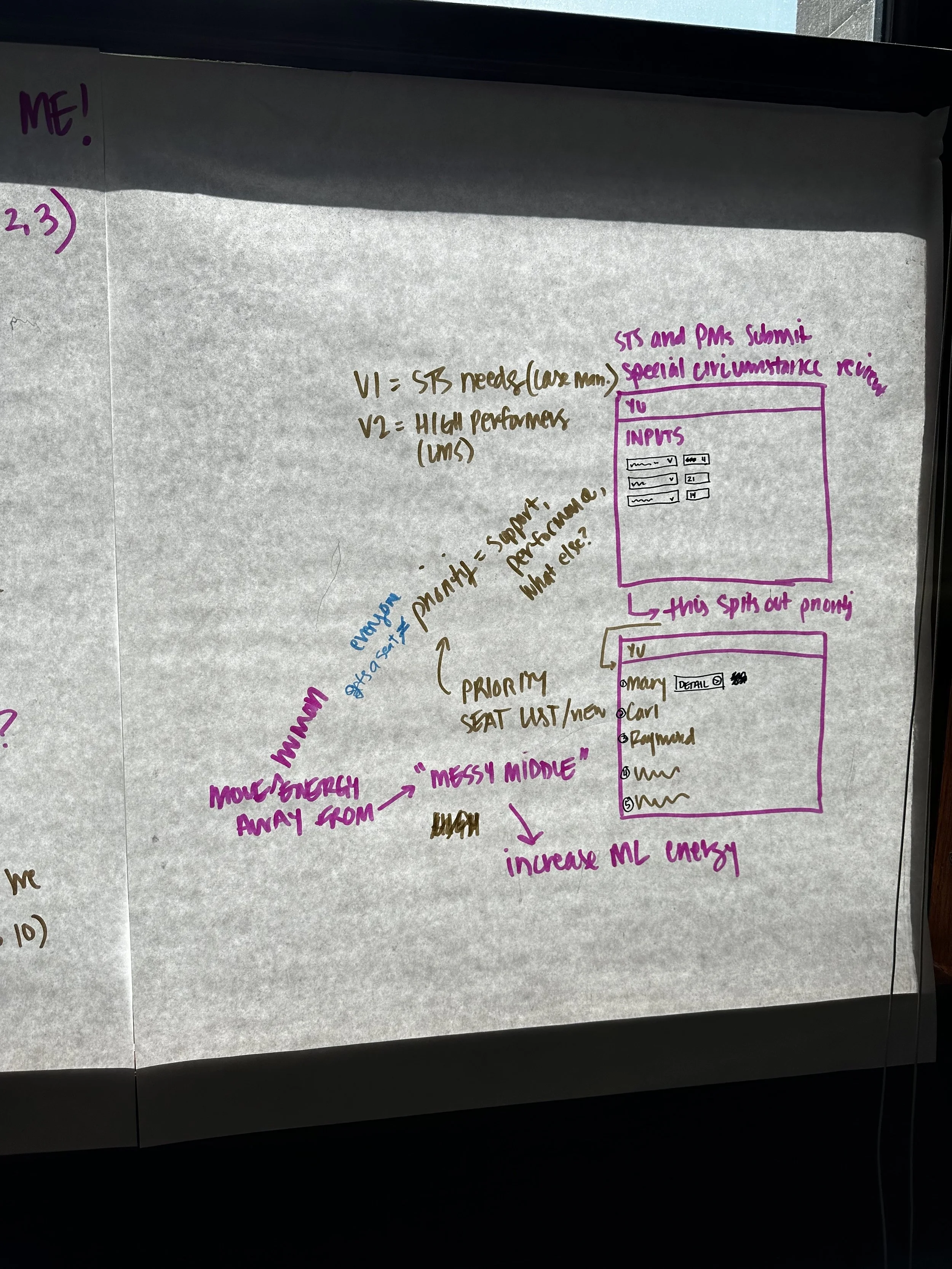Additional Projects
At Year Up United, I led several other impactful initiatives during my nearly four years with the organization—focusing on optimizing complex, B2B SaaS based workflows. These projects reflect my ability to scale enterprise tools, drive cross-functional alignment, and improve adoption across national teams.
Note: Due to company policy and the sensitive nature of the work—including proprietary partner data, personal information of young adults, and Salesforce integrations tied to Fortune 500 companies—I’m unable to publicly share full prototypes or detailed UI for most Year Up projects. The UIs, mockups, and wireframes shared here have been pre-authorized for use on this portfolio. Each summary emphasizes the UX strategy, process, and impact of my work.
Centralized Demand
October 2022 - March 2023
Transformed Year Up United’s national sales & pipeline intake system in Salesforce, unlocking $2.1M in new revenue and achieving 100% adoption across all teams.
Context
Year Up United's previous demand intake process relied on a confusing “Lead Generation” tool within Salesforce that lacked standardization, used ambiguous record types, and offered no clear feedback loop. These inefficiencies caused widespread adoption issues, limited visibility into pipeline activity, and made it difficult to scale corporate internship partnerships, which directly tied to the organization’s revenue and our Fortune 500 clients’ DEIB goals.
The Problem
Sales staff needed a streamlined, intuitive system to log internship demand across accounts in a consistent way—one that aligned with real sales workflows and Salesforce constraints. The original tool led to data silos, manual workarounds, and inaccurate tracking that hindered national forecasting and sales planning.
My Role
As the lead product designer, I worked cross-functionally with Product, Engineering, Business Services, and National Sales to:
Audit and deconstruct the original “Lead Generation” experience
Redesign the entire flow for demand intake and multi-seat entry
Simplify UI, nomenclature, and interaction patterns to reduce user friction
Create onboarding support including in-product guidance, tutorials, and Q&A sessions to smooth adoption
Shepherd the tool into production and support feedback iterations post-launch
Process Highlights & UI Samples
Curated UX research strategy outline, user interview guides, and pre/post-launch surveys
Recruited and studied 13 CE and national account managers
Analyzed user sentiment, behaviors, workflow, and pain points of original demand capture process
Conducted three rounds of moderated and unmoderated usability testing with CE staff and national account managers
Used Single Ease Questions (SEQ) and pass/fail task completion to validate UI flows
Resolved core UX pain points around:
Inability to submit more than one partner Demand at a time
Non-standard, region-specific data entry fields
Ambiguous “Record Types”
Manual city/state entry (replaced with dropdowns)
Confusing CTAs like “Add Demand” (clarified into “Add Additional Demand”)
Redesigned Salesforce UI and defined a standardized intake model—enabling confident, scalable entry of multi-seat, multi-cohort internship demand across all regions.
Shipped Centralized Demand into production - now fully active across all sales teams at Year Up United
Outcome & Impact
103 new internship seats captured post-launch
Estimated $2.1M in additional revenue (at $20.5K/seat)
100% adoption across all Year Up United sales teams nationwide (confirmed by Business Services)
77% of users reported “high confidence” or “confidence” in using the tool (up from 40%)
88% rated the experience as “good” or “very good” (previously 66% “neutral” or “bad”)
Tool became a core operational platform for account management and intake forecasting
Reflections
Designing Centralized Demand pushed me to think beyond interface design and focus deeply on organizational clarity, user trust, and operational scalability. What began as a fix for a fragmented intake tool evolved into a full-scale, UX-led system redesign—one that required not just thoughtful form flows, but the creation of a standardized data model flexible enough to scale across diverse regional markets.
In hindsight, I would have invested even more in change management—especially around storytelling and internal advocacy to help regional teams understand the “why” behind the shift. While the rollout was successful, deeper behavioral alignment might have further amplified the tool’s long-term impact.
Still, the most rewarding outcome wasn’t just increased revenue—it was seeing 100% adoption driven by genuine user trust. Watching the tool shift from low engagement to something staff actively relied on was a clear reminder that good UX is ultimately about empowering people to work better.
With the company fully realized into Centralized Demand 2.0, I’m exceptionally proud to have laid the foundation for a platform that’s no longer just used—but trusted.
Future State Matching
June 2024 - November 2024
Envisioned and led the design of Year Up United’s next-gen AI-powered Matching system—leveraging stable marriage theory to prototype scalable, cohort-based placement across national internship programs.
Context
Following the successful launch of the Predictive Matching interface, I began envisioning a next evolution of the tool—a future where entire cohorts of students could be matched to internships at scale using AI, not just manually reviewed one by one. Partnering again with AdeptID, I explored how their stable marriage algorithm could enable this shift, transforming Matching into a cohort-based, auto-optimized system informed by the Fit Score logic I had helped pioneer.
The Problem
The existing Matching tool still required staff to manually select and evaluate individual student-internship pairings, limiting scalability and efficiency—especially for larger cohorts or partner companies with high seat volume. There was no mechanism to support multi-student-to-multi-seat automation.
My Role
As the initiator and design lead, I:
Pitched and socialized the vision to Product, Engineering, and AdeptID’s AI specialists
Planned, facilitated, and led a 3-day in-person cross-functional design workshop in Boston
Unified voices from program management, engineering, design, executive leadership, and AI
Led a week-long follow-up design sprint to sketch and wireframe cohort-based workflows and interfaces
Converted sketches into mid-fidelity flows and prototypes, using Figma and the Salesforce Lightning Design System
Collaborated with engineering on technical feasibility and architectural implications
Process Highlights
Explored AI-assisted batch matching powered by stable marriage theory
Created flows for multi-student intake, automated match suggestions, and human control through confidence-based overrides
Designed UI patterns for:
Automated bulk matching IA & visual layout
“Trust but verify” functionalities
Bulk confirmation actions
Match explanation/justification logic
Produced a skeleton IA and wireframe screen flows aligned with Predictive Matching's foundation
Early Sketches & Ideation
Sketch to illustrate potential IA of Future State Matching, with automated batch matches and confirmation actions.
Sketch detailing two potential views that program managers can have access to for automated matching
Wireframe Screens
Rough draft wireframe of the landing page for Future State Matching, with each Student Matched with best internship options, blending Fit Score logic with AI-automated pairings.
Intended Impact
Enable scalable, automated cohort-to-seat matching
Increase efficiency for staff handling high-volume placement periods
Reduce human bias and decision fatigue
Empower users to override or fine-tune AI recommendations with full visibility and control
Lay the groundwork for AI integration into Year Up’s core placement pipeline
Why It Was Shelved
Despite internal excitement and stakeholder buy-in, the project was shelved in November 2024 following a significant organizational realignment. The federal government’s rollback of national DEIB policy caused uncertainty among Year Up United’s primary funding partners—including Fortune 500 internship sponsors and donors—leading to strategic pullback, team reductions, and the elimination of long-term technical investments.
Before my departure as part of a broader reduction in force, I proactively ensured that all designs, flows, and architectural plans were fully documented, annotated, and organized into a handoff-ready package, should the initiative be revived in the future. As of mid-2025, the Future State Matching project remains inactive.
Reflections
This project was a rare opportunity to apply speculative UX to a real organizational problem in B2B SaaS, grounded in data and AI partnerships. It challenged me to operate at a strategic product level, while balancing stakeholder ambition with platform constraints. While the shelving of the project was disheartening, I’m proud to have laid the conceptual foundation for a Matching system that was visionary, cross-functional, and deeply user-informed. The experience underscored that great design isn’t always about launch—it’s about asking the right questions and pushing the organization toward what could be.












